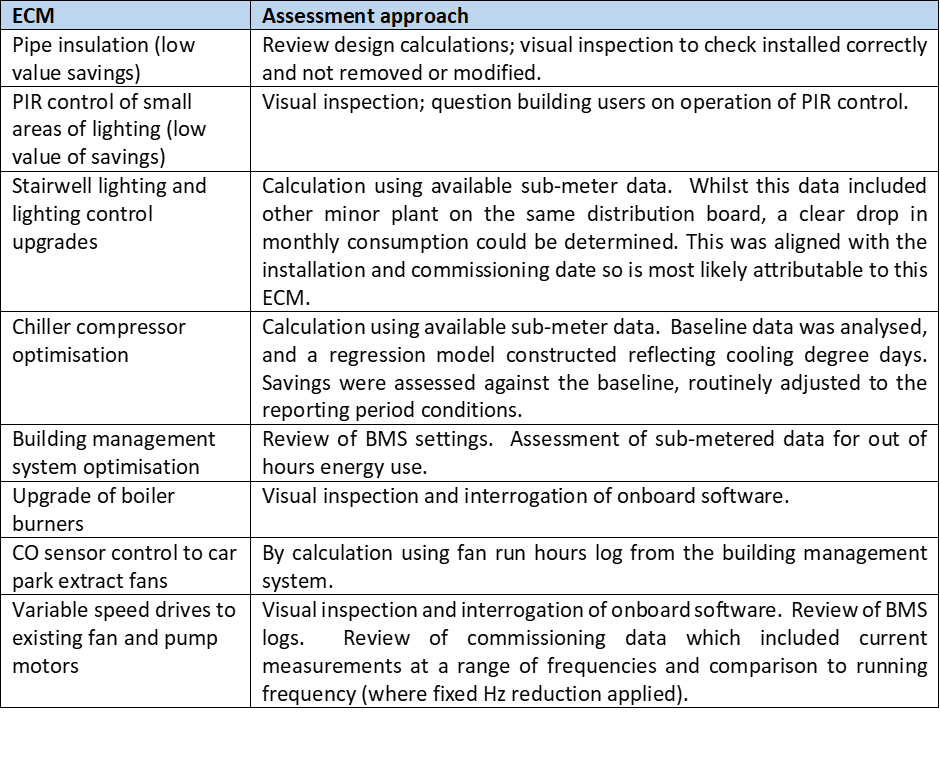![]() By Colin Grenville*
By Colin Grenville*
Finding the right balance between cost and accuracy is a key consideration in designing an M&V strategy which provides adequate certainty of measurement without wholly cannibalising the avoided energy cost. This is particularly an issue on complex multi-ECM projects where some ECMs interact, and where isolation of performance of remaining ECMs cannot be undertaken using pre-existing metering.
Such a scenario was encountered by energy company E.ON, acting as ESCO for their client Transport for London (“TfL”) on a project procured under RE:FIT public sector framework in the U.K. The project covered nine premises, of which two used a two-tiered approach to M&V. This addressed the following contractual and client needs:
- To deliver a savings guarantee, measured to the standard required under the contract and adhering to the IPMVP. For this, an Option C approach was suitable due to the interactive nature of some of the ECMs, the materiality of the % savings anticipated relative to the baseline, and the availability of existing metering.
- To deliver as much additional management information about the individual ECM savings as possible to identify any ECMs which were not performing and help guide future ECM procurement, maintenance personnel and help pinpoint potential improvements. A degree of uncertainty in the results is acceptable, and minor ECMs can be reviewed by visual inspection only.
The IPMVP Generally Accepted Principles (October 2018) states: “M&V costs should normally be “small” relative to the monetary value of the savings being evaluated. M&V expenditures should also be consistent with the financial implications of over-or under-reporting of a project’s performance.”
In this example, the ESCO’s savings guarantee to their client sat at project level (not at building or ECM level), so the performance of individual ECMs was a subsidiary issue, if the overall project performed above target. Should performance fall, the availability of ECM level data becomes essential for gap diagnosis. One would also hope the ECMs to continue to perform beyond the life of the performance contract, so ensuring all are working as well as anticipated is vital to maximise savings across the ECM lifespan.
Two alternative tiered M&V approaches were considered.
“Nested” Option C using deduction of individually measured ECMs from total site usage.
This approach considered measurement of individual ECMs (where technically feasible to isolate performance) using Option A or B techniques, and then measuring what is left of total building energy use using an “adjusted Option C” (with the measured ECMs deducted). This sets the measurement boundaries as shown in Fig1 below:
Figure 1
Measurement boundaries for "Nested Option C" two-tiered approach.

Advantages:
- Accuracy
- Strong understanding of all ECMs that can be individually isolated and measured
- Reduced boundary for Option C diminishes risk of changes in static factors and need for non-routine adjustments.
Disadvantages:
- Cost
- No change to guaranteed savings or relief from commercial risk as savings guarantee does not sit at ECM level.
- More complex to assess Option C baseline and report ongoing savings. The need to deduct individually measured ECMs from the overall site usage is problematic where the Option A or B approach for an ECM proposes spot measurements with periodic re-tests rather than ongoing metered performance.
- Need to ensure that ECMs remaining to be measured using Option C offer savings that exceed the minimum threshold recommended for Option C, albeit for the reduced boundary. The rule of thumb is 10% minimum savings.
- Gas saving ECMs were generally uneconomic to individually measure (e.g. because only 2 out of 3 boilers were replaced, no sub-metering existing, and scheduling of individual boilers would require all to have new metering).
In this approach, some ECMs are individually measured and the remainder are covered by Option C using a reduced measurement boundary created by deducting the individually measured ECMs from the overall site utility meter data.
Building level Option C measurement, and indicative performance assessment of subsidiary ECMs
Given the disadvantages listed for the previous approach, and the client’s acceptance of some uncertainty on the accuracy of ECM level performance, a less onerous assessment strategy was utilised. Though not giving the rigorous assessment of uncertainty of the results for individual ECMs this provided satisfactory results to guide future decision making and assess the general performance of ECMs. Uncertainty and rigour of results was covered under the overall Option C measurement.
Figure 2
Building level Option C, with “best endeavours” reporting for individual ECMs.

A range of techniques were used to validate the performance of individual ECMs including:

Summary
The exercise of re-evaluating individual ECMs within an Option C overall building boundary was immensely worthwhile, providing useful insight into the performance of individual ECMs. It was not possible to conclusively determine performance for all ECMs. However, it was possible to conclude that many had been very successful. Additionally, comparing results at ECM and site level ensured the overall performance observed at Option C level was most likely attributable to the ECMs and unlikely to include significant other unidentified factors. Key success factors included a client who knew their buildings and metering intimately and could suggest reasons for changes in profiles, and a strong and functional enduring relationship between ESCO, client and their sub-contractors.

(*) Colin Granville is Director at Erebus Environment Ltd.





